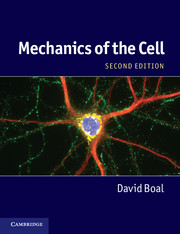Book contents
- Frontmatter
- Contents
- Preface
- List of symbols
- 1 Introduction to the cell
- 2 Soft materials and fluids
- Part I Rods and ropes
- Part II Membranes
- Part III The whole cell
- 10 The simplest cells
- 11 Dynamic filaments
- 12 Growth and division
- 13 Signals and switches
- Appendix A Animal cells and tissues
- Appendix B The cell’s molecular building blocks
- Appendix C Elementary statistical mechanics
- Appendix D Elasticity
- Glossary
- References
- Index
10 - The simplest cells
Published online by Cambridge University Press: 05 June 2012
- Frontmatter
- Contents
- Preface
- List of symbols
- 1 Introduction to the cell
- 2 Soft materials and fluids
- Part I Rods and ropes
- Part II Membranes
- Part III The whole cell
- 10 The simplest cells
- 11 Dynamic filaments
- 12 Growth and division
- 13 Signals and switches
- Appendix A Animal cells and tissues
- Appendix B The cell’s molecular building blocks
- Appendix C Elementary statistical mechanics
- Appendix D Elasticity
- Glossary
- References
- Index
Summary
Most cells have a complex internal structure of biological rods, ropes and sheets. In terms of the metaphors for the cell in Chapter 1 – a hot air balloon, a sailing ship – our task in Parts I and II of this text was to analyse the individual structural elements of the cell – the masts, rigging and hull – without regard to their interconnection. In Part III, we begin to assemble the units together to form composite systems. As the introduction to Part III, Chapter 10 treats the equilibrium shapes of the simplest systems, namely cells or vesicles without a nucleus or space-filling cytoskeleton. A thorough treatment of complex cells is beyond the reach of our analytical tools; rather, we mention a selection of their properties in Chapters 11 and 12. In Chapter 11, we describe mechanisms that cells have developed for changing their shape, as part of cell division or locomotion, for example. Cell division proper is the subject of Chapter 12, including changes to the division cycle over the history of the Earth. Lastly, in Chapter 13, we study methods that have evolved for control and organization in the cell, using specific situations as examples.
- Type
- Chapter
- Information
- Mechanics of the Cell , pp. 373 - 411Publisher: Cambridge University PressPrint publication year: 2012



